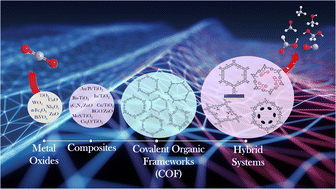From conventional inorganic semiconductors to covalent organic frameworks: advances and opportunities in heterogeneous photocatalytic CO2 reduction
Abstract
Solar-driven photochemical CO2 reduction over semiconducting materials is a strategic technology towards sustainable development as it represents a source of renewable liquid and gaseous fuels, and simultaneously provides a solution for current environmental problems caused substantially by the accumulation of this greenhouse gas in the atmosphere. However, the unfavorable thermodynamics and the sluggish kinetics of the multi-electron CO2 reduction reactions pose several challenges in terms of selectivity, conversion efficiencies, and long-term stability. Continuous advances have been made by different research groups on the fundamental understanding of the relationship between the CO2 conversion efficiency and the physicochemical properties of the photocatalyst. This review aims to present the main findings in this field to a broad audience, starting with the application of conventional inorganic semiconductors as photocatalysts for CO2 reduction, followed by the introduction of covalent organic frameworks as a new generation of photocatalytic materials. The rational design of organic–inorganic hybrids to enhance the activity and selectivity of the CO2 reduction is also summarized along with the remaining challenges regarding both fundamental understanding and potential upscaling.

- This article is part of the themed collection: Journal of Materials Chemistry A Recent Review Articles


 Please wait while we load your content...
Please wait while we load your content...